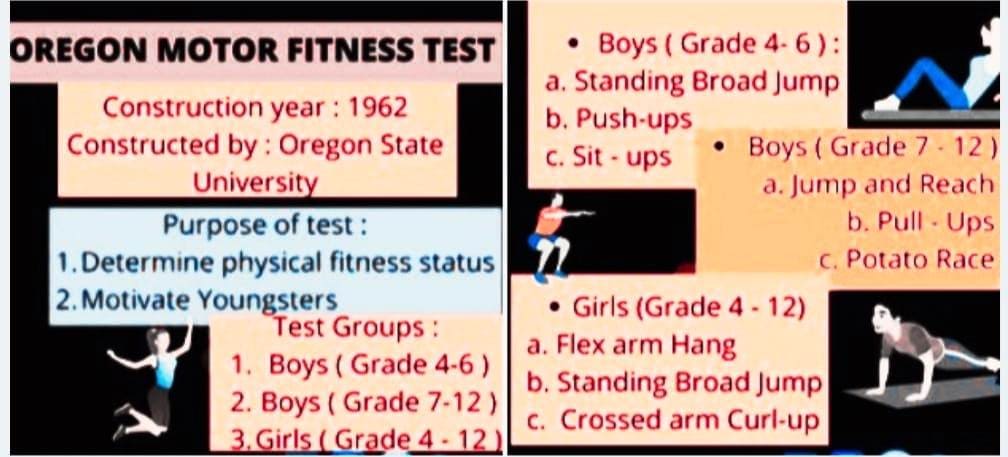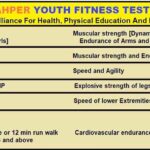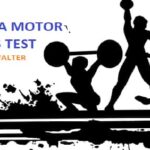OREGON MOTOR FITNESS TEST
The Oregon Motor Fitness test was constructed by the University of Oregon in the year of 1962. The elements selected for this test were: arm and shoulder girdle strength and endurance, abdominal strength and endurance, muscular power, running speed and endurance, agility, and trunk flexibility.
The construction of the tests followed essentially the same pattern for both males and females at the school levels.
BOYS BATTERIES
Upper Elementary School: The test items for boys in grades four, five, and six are:
- Standing Broad Jump,
- Floor Push-Ups
- Sit-Ups.
Standing Broad Jump:
For leg explosive power- A take-off line is drawn on the floor, ground, or mat. At a distance, all can jump, but at an even number of feet for convenience, a second line is drawn; additional parallel lines two inches apart position with toes just touching the take-off line, feet slightly apart. Taking off from both feet simultaneously, he jumps far as possible, landing on both feet; in jumping, he crouches slightly and swings his arms to aid the jump. Scoring is the distance from the nearest inch from the take-off line to the closest heel position; if the pupil falls back, he should retake the test. The best three trails are recorded.
Floor Push-ups:
For shoulder strength- The boy takes front–leaning rest position with the body supported on hands and balls of feet; the arms are straight and at right angles to the body. He then dips or lowers the body so that the chest touches or nearly touches the floor, then pushes back to the starting position by straightening the arms, and repeats the procedure as many times as possible. In performing floor push-ups, only the chest should touch the floor; the arms must be completely extended with each push-up; the body must be held straight throughout. Scoring consists of a number of correct push-ups.
Knee-touch sit-ups:
For abdomen strength- The boy lies on his back, knees bent, feet about 12 inches apart, and hands clasped behind his head. A scorer kneels on the floor and holds the feet, pressing firmly. The boy performs the following movement as many times as possible: raise the trunk rotating it somewhat to the right, and bend forward far enough to touch the right elbow to the left knee; lower the trunk to the floor; sit up again, but rotate the trunk to the left and touch left elbow to the right knee; again, lower the trunk to the floor. The knees may be slightly bent as the boy sits up. However, he must not pause during the test, and bouncing from the floor is not permissible. In scoring one point is given for each complete movement of touching elbow to knee.
OREGON TEST FOR JUNIOR AND SENIOR HIGH SCHOOLS
The test items for boys in both junior high school and senior high school are the same: Jump and reach, pull-ups, and 160-yard potato race.
Pull-up:
The bar should be located high enough so that the feet of the tallest boy do not touch the floor when performing the test. In taking the pull-up test the subject hangs from the bar by his hands with a forward hand grip and chins himself as many times as he can. In executing the movement, he should pull himself up until his chin is even with his hands, and then lower himself until his arms are straight. He should not be permitted to kick, jerk, or use a kip motion. Half counts are recorded if the subject does not pull all the way up, if he does not straighten his arms completely when lowering the body, or if he kicks, jerks, or kips in performing the movement. Only four half-counts are permitted.
Jump and Reach:
A yardstick or tape measure is taped to the wall to measure the distance between to chalk marks. The test performer stands with the dominant side toward the wall and feet flat on the floor; holding a piece of chalk in the dominant hand, reach as high as possible and makes a mark on the wall; and jumps as high as possible and makes another mark at the height of the jump. Three trials are administered. Rather than using a piece of chalk to make the mark, chalk powder can be placed on the fingertips. For each jump, the score is the distance between the two chalk marks, measured to the nearest half inch. The greatest distance is the test score.
160-yard potato race:
Three circles, each one foot in diameter, are drawn on the floor in line with each other. Circle 1 is behind and tangent to a starting line. The center of circle 2 is 50 feet from the starting line, and circle 3 is 69 1/2 feet from the starting line. One 2/4 inch block or eraser is placed in circle 2, and a second one is placed in circle 3. From a standing start, the subject runs to circle 2, picks up the block, returns to circle 1, and places it in the circle; he then runs to circle 3, picks up the block, and carries it to circle 1; he immediately picks up the first block, carries it back to circle 2; he then returns to circle 1, picks up the second block and carries it to circle 3; finally, he races back across the starting line. The blocks must be placed, not dropped or thrown, in the proper circle each time. The score is the elapsed time in seconds.
GIRL’S BATTERIES IN OREGON FITNESS TEST
The Oregon Motor Fitness test items for girls are;
- Hanging in an arm-flexed position,
- Standing broad jump and,
- Crossed arm curl-ups.
Hanging in an arm-flexed position:
The girl stands on a stool or other support; placing her hand shoulder-width apart, palms outward, on a one-inch standard horizontal bar or ladder with elbows flexed to permit the chin to be level with the bar. The support is removed. The girl holds her chin at the level of the bar as long as she can do so. (The legs should remain extended throughout.) The score is the number of seconds the student is able to maintain some flexion in the elbow, preventing the elbow from straightening. The chin should not rest on the bar.





